Whether it’s a term break for a few weeks or three months of summer vacation, going back to school is a time chock-full of possibility and change. The books in this collection reflect experiences of students as they return to the classroom, including the anticipation of the transition to a new school environment, as well as challenges and discoveries through the year.
Ages 4–8
The Class. Boni Ashburn. Ill. Kimberly Gee. 2016. Beach Lane/Simon & Schuster.
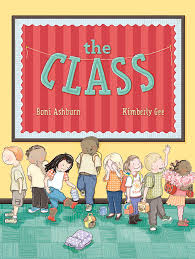 Twenty children prepare for the first day of kindergarten in this narrative written in rhyme, starting with steps such as getting up in the morning and selecting what to wear. “Six have laid clothes on a chair./ Three don’t know what to wear!/ Five pull on their favorite jeans./ Two are fashionista queens.” On each spread is a number of children with different emotional expressions, showing different ways of dealing with each step in getting to school, where nervous, friendly, shy, playful, or busy they meet on the playground before going to their classroom. Illustrations, rendered in pencil and colored digitally, include details of the children’s school-day routines of dressing, finishing breakfast in spite of being excited, and getting their belongings together, as well as the anxieties, fears, and even frustrations on the first day.
Twenty children prepare for the first day of kindergarten in this narrative written in rhyme, starting with steps such as getting up in the morning and selecting what to wear. “Six have laid clothes on a chair./ Three don’t know what to wear!/ Five pull on their favorite jeans./ Two are fashionista queens.” On each spread is a number of children with different emotional expressions, showing different ways of dealing with each step in getting to school, where nervous, friendly, shy, playful, or busy they meet on the playground before going to their classroom. Illustrations, rendered in pencil and colored digitally, include details of the children’s school-day routines of dressing, finishing breakfast in spite of being excited, and getting their belongings together, as well as the anxieties, fears, and even frustrations on the first day.
Mission: Back to School. Susan Hood. Ill. Mary Lundquist. 2016. Random House.
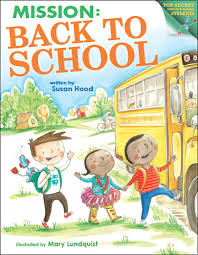 This manual for navigating first days back at school cautions readers that it is “classified information.” Chapter headings on each page indicate reconnaissance and intrigue in the choice of language. “Rendezvous at vehicle checkpoint” is getting on the bus. “Build diplomatic relations” is learning to say hello in multiple languages. “Conduct fieldwork” is observing insects on the school grounds. The language has multiple meanings. On the spread of a field trip near the school, for example, different children speak while they work. One child says, “Let’s sweep the area for bugs,” while another says, “Watch out it’s a sting operation.” A third student calls out, “Bring on the Swat team.” The playful illustrations, done in pencil and colored ink, depict sharing referred to as “trading assets,” learning conventions of behavior in class, called “learning secret code,” and other aspects of the daily life of the class.
This manual for navigating first days back at school cautions readers that it is “classified information.” Chapter headings on each page indicate reconnaissance and intrigue in the choice of language. “Rendezvous at vehicle checkpoint” is getting on the bus. “Build diplomatic relations” is learning to say hello in multiple languages. “Conduct fieldwork” is observing insects on the school grounds. The language has multiple meanings. On the spread of a field trip near the school, for example, different children speak while they work. One child says, “Let’s sweep the area for bugs,” while another says, “Watch out it’s a sting operation.” A third student calls out, “Bring on the Swat team.” The playful illustrations, done in pencil and colored ink, depict sharing referred to as “trading assets,” learning conventions of behavior in class, called “learning secret code,” and other aspects of the daily life of the class.
Sophie’s Squash Go to School. Pat Zietlow Miller. Ill. Anne Wilsdorf. 2016. Schwartz & Wade/Random House.
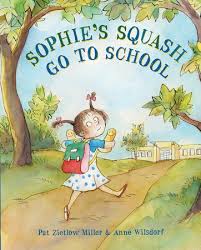 Going to school can inspire excitement as well as create anxiety, so Sophie brings two butternut squash, Bonnie and Baxter, with her to ease her way into starting kindergarten. Reprised from 2013’s Sophie’s Squash, the girl is so involved with her two friends that she stays away from the other children and rebuffs invitations to play and work in small groups. In this story of first-day-of-school adjustment and making new friends, Sophie is irritated by everything in school and rebuffs Steven Green, who wants to be friends. To encourage friendship with Sophie, Steven shares his special friend, a stuffed frog, with her, but to no avail. When she finally shares her squash during morning meeting, he corrects her reference to them as vegetables rather than fruits. Sophie has to make decisions about her special squash friends, and in her growing understanding of what friends are she introduces a project to the class. The illustrations, rendered in watercolor and China ink, depict new experiences and beginnings at home and in school. The enchanting end sheets, showing Sophie interacting with her two friends on a chair, are different front and back.
Going to school can inspire excitement as well as create anxiety, so Sophie brings two butternut squash, Bonnie and Baxter, with her to ease her way into starting kindergarten. Reprised from 2013’s Sophie’s Squash, the girl is so involved with her two friends that she stays away from the other children and rebuffs invitations to play and work in small groups. In this story of first-day-of-school adjustment and making new friends, Sophie is irritated by everything in school and rebuffs Steven Green, who wants to be friends. To encourage friendship with Sophie, Steven shares his special friend, a stuffed frog, with her, but to no avail. When she finally shares her squash during morning meeting, he corrects her reference to them as vegetables rather than fruits. Sophie has to make decisions about her special squash friends, and in her growing understanding of what friends are she introduces a project to the class. The illustrations, rendered in watercolor and China ink, depict new experiences and beginnings at home and in school. The enchanting end sheets, showing Sophie interacting with her two friends on a chair, are different front and back.
Ages 9–11
The Only Girl in School. Natalie Standiford. 2016. Scholastic.
 After Bess, Claire’s best friend, moves to California, Claire is the only girl in the fifth-grade class at the school on Foyes Island. In a series of letters to Bess, Claire chronicles the year and shares her hurt and disappointment when her other best friend, Henry, ignores her as he joins in the torment and bullying the boys in the school instigate and which goes unnoticed by the teachers. To survive the bullying, Claire escapes to her clubhouse—the girls’ bathroom—where she illustrates daily events and, when she discovers that someone has been adding pictures that ridicule her to the bathroom stalls, she has a mystery to solve. A winter play, square dance, spring sailing regatta, Claire’s birthday party, and a social studies project in which Claire proposes to solve another mystery related to the history of the island, provide moments when Claire begins to stand up to her tormentors. In her story of betrayal, resourcefulness, and forgiveness, Claire finds her identity and pursues interests that are important to her.
After Bess, Claire’s best friend, moves to California, Claire is the only girl in the fifth-grade class at the school on Foyes Island. In a series of letters to Bess, Claire chronicles the year and shares her hurt and disappointment when her other best friend, Henry, ignores her as he joins in the torment and bullying the boys in the school instigate and which goes unnoticed by the teachers. To survive the bullying, Claire escapes to her clubhouse—the girls’ bathroom—where she illustrates daily events and, when she discovers that someone has been adding pictures that ridicule her to the bathroom stalls, she has a mystery to solve. A winter play, square dance, spring sailing regatta, Claire’s birthday party, and a social studies project in which Claire proposes to solve another mystery related to the history of the island, provide moments when Claire begins to stand up to her tormentors. In her story of betrayal, resourcefulness, and forgiveness, Claire finds her identity and pursues interests that are important to her.
Ages 12–14
The Last Boy at St. Edith’s. Lee Gjersten Malone. 2016. Aladdin/Simon & Schuster.
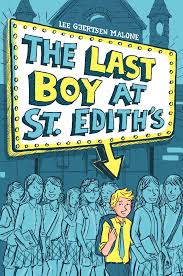 Seventh-grade student Jeremy Miner longs to attend a school other than St. Edith’s School, formerly an all-girls’ school that briefly admitted boys. All the other boys have now transferred, but Jeremy has to stay because he receives free tuition to the prestigious school because his single mother is on staff. His sister, Rachel, an athlete and excellent student, and an old friend, Emily, who also go to St. Edith’s, chide him for wanting to change schools. Only one student, Claudia, sympathizes and plans a series of epic pranks with Jeremy that involve the whole school with the intention of getting him kicked out. Jeremy establishes rules for the pranks and the first few are pulled off successfully. Then events begin to conspire against the pranksters. Their acts affect more schools than just St. Edith’s and involve many of the students, causing Jeremy to question himself and what he thinks is important. In this novel of friendship lost and found, resourcefulness, and unexpected consequences, Jeremy learns that being the only boy in school is not the worst thing that can happen.
Seventh-grade student Jeremy Miner longs to attend a school other than St. Edith’s School, formerly an all-girls’ school that briefly admitted boys. All the other boys have now transferred, but Jeremy has to stay because he receives free tuition to the prestigious school because his single mother is on staff. His sister, Rachel, an athlete and excellent student, and an old friend, Emily, who also go to St. Edith’s, chide him for wanting to change schools. Only one student, Claudia, sympathizes and plans a series of epic pranks with Jeremy that involve the whole school with the intention of getting him kicked out. Jeremy establishes rules for the pranks and the first few are pulled off successfully. Then events begin to conspire against the pranksters. Their acts affect more schools than just St. Edith’s and involve many of the students, causing Jeremy to question himself and what he thinks is important. In this novel of friendship lost and found, resourcefulness, and unexpected consequences, Jeremy learns that being the only boy in school is not the worst thing that can happen.
Surviving Middle School: Navigating the Halls, Riding the Social Roller Coaster, and Unmasking the Real You. Luke Reynolds. 2016. Beyond Words/Aladdin/Simon & Schuster.
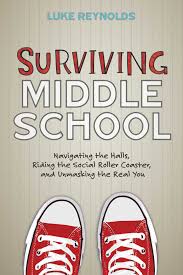 In a conversational and humorous style, Reynolds, a middle school teacher, tells stories from his teaching experience, illustrating lessons for living through middle school. He devotes individual chapters to such topics as the hazards of comparing oneself to classmates or one’s accomplishments to those of others, what matters to young people, and how to understand others. He introduces the iceberg concept by recounting experiences of students and explains that young people and adults are much more complex than they appear on the surface. Reynolds dispels myths, or what he calls lies, that can be perplexing for middle school students, such as “Lie #1: The way you look is all that matters when it comes to love and Lie #2: If you’re not going out with someone in middle school, you’re not cool.” His stories and topics reflect a metaphor of “caked dirt” he introduces at the beginning. By explaining how caked dirt can persist in bicycle tires, refusing to come out even with scrubbings, he shows how being caked dirt means not giving up. Students do not give up on pursuing their interests and talents, and teachers do not give up on trying again, learning, and supporting students. He uses quotations from writers throughout and includes a reference list of books, articles, and websites that he integrates into the chapters.
In a conversational and humorous style, Reynolds, a middle school teacher, tells stories from his teaching experience, illustrating lessons for living through middle school. He devotes individual chapters to such topics as the hazards of comparing oneself to classmates or one’s accomplishments to those of others, what matters to young people, and how to understand others. He introduces the iceberg concept by recounting experiences of students and explains that young people and adults are much more complex than they appear on the surface. Reynolds dispels myths, or what he calls lies, that can be perplexing for middle school students, such as “Lie #1: The way you look is all that matters when it comes to love and Lie #2: If you’re not going out with someone in middle school, you’re not cool.” His stories and topics reflect a metaphor of “caked dirt” he introduces at the beginning. By explaining how caked dirt can persist in bicycle tires, refusing to come out even with scrubbings, he shows how being caked dirt means not giving up. Students do not give up on pursuing their interests and talents, and teachers do not give up on trying again, learning, and supporting students. He uses quotations from writers throughout and includes a reference list of books, articles, and websites that he integrates into the chapters.
Where You’ll Find Me. Natasha Friend. 2016. Farrar Straus Giroux.
 When 13-year-old Anna Collette’s mother is hospitalized from an overdose of antidepressants, Anna must go live with her estranged father, his young wife, and their baby. Although Anna has focused on the ups and downs of her mother’s health, even when her parents were married, now she also has to deal with the rejection of her lifelong best friend, Dani, who has tried out for the cheerleading squad and joined the cool girls. Despondent and disoriented, Anna resists the friendship of Shawna and SaraBeth, who suggest they try out for the annual talent show. As her mother improves and takes up residence with her old friend Regina, a nurse, Anna is apprehensive about communicating with her mother and has a falling out with her father, who has always left care of her mother to others. Anna finds ways to forge a new life and realize the talents she has as she reconciles her relationships with family and discovers new friendships in this novel of identity and discovery.
When 13-year-old Anna Collette’s mother is hospitalized from an overdose of antidepressants, Anna must go live with her estranged father, his young wife, and their baby. Although Anna has focused on the ups and downs of her mother’s health, even when her parents were married, now she also has to deal with the rejection of her lifelong best friend, Dani, who has tried out for the cheerleading squad and joined the cool girls. Despondent and disoriented, Anna resists the friendship of Shawna and SaraBeth, who suggest they try out for the annual talent show. As her mother improves and takes up residence with her old friend Regina, a nurse, Anna is apprehensive about communicating with her mother and has a falling out with her father, who has always left care of her mother to others. Anna finds ways to forge a new life and realize the talents she has as she reconciles her relationships with family and discovers new friendships in this novel of identity and discovery.
Ages 15+
How It Ends. Catherine Lo. 2016. Houghton Mifflin Harcourt.
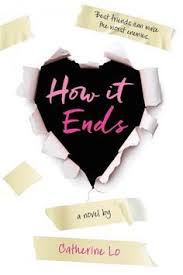 Annie and Jessie are unlikely friends who find each other at the beginning of sophomore year. Annie is cool, outgoing, new in town, and an artist, living with her father, stepmother, and older, perfect stepsister. Jessie is introverted, a conscientious student, and a writer, with a secure, supportive family. Annie and Jessie recount the year from alternative perspectives, as Annie develops friendships with Courtney and her friends, who continue to torment and harass Jessie as they have since middle school. Annie is blind to their actions and chides Jessie about imagined slights and offenses until Jessie’s mother mentions to Annie the anxiety that afflicts Jessie. Annie realizes she can be a better friend by changing how she behaves and shares Jessie’s information with her other friends, thinking that this will change their behavior toward her. Both Annie and Jessie like the same boy, Scott Hutchins, but Annie takes up with him and when she enlists Jessie’s help in doing a pregnancy test, Jessie learns what Annie wants to keep secret. As they each meet the challenges of their secrets they gain insight into themselves and their relationships with friends and family, discovering what and who is important in their lives.
Annie and Jessie are unlikely friends who find each other at the beginning of sophomore year. Annie is cool, outgoing, new in town, and an artist, living with her father, stepmother, and older, perfect stepsister. Jessie is introverted, a conscientious student, and a writer, with a secure, supportive family. Annie and Jessie recount the year from alternative perspectives, as Annie develops friendships with Courtney and her friends, who continue to torment and harass Jessie as they have since middle school. Annie is blind to their actions and chides Jessie about imagined slights and offenses until Jessie’s mother mentions to Annie the anxiety that afflicts Jessie. Annie realizes she can be a better friend by changing how she behaves and shares Jessie’s information with her other friends, thinking that this will change their behavior toward her. Both Annie and Jessie like the same boy, Scott Hutchins, but Annie takes up with him and when she enlists Jessie’s help in doing a pregnancy test, Jessie learns what Annie wants to keep secret. As they each meet the challenges of their secrets they gain insight into themselves and their relationships with friends and family, discovering what and who is important in their lives.
Sandip Wilson serves as associate professor in the College of Health and Education of Husson University in Bangor, ME.
These reviews are submitted by members of the International Literacy Association's Children's Literature and Reading Special Interest Group (CL/R SIG) and are published weekly on Literacy Daily.